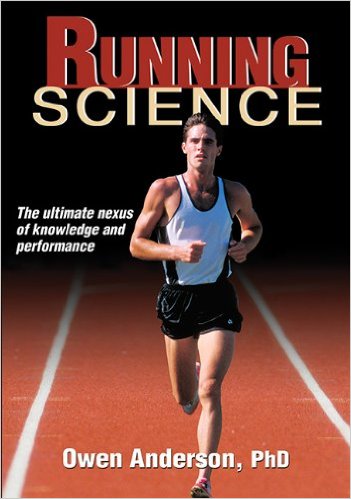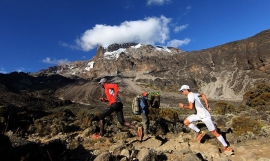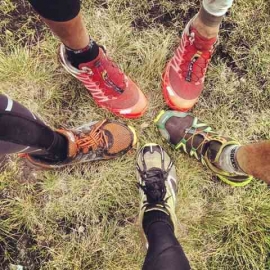《Running Science》电子书下载地址:
Running Science_Owen Anderson_2013.pdf
//www.nduoke.com//www.nduoke.com/shujixiazai/073607418x-running-science-download
《Running Science》简介:
More than 50 years ago, New Zealand’s Arthur Lydiard started using terms like base training, periodization, and peaking. His U.S. counterpart, Bill Bowerman, brought Lydiard’s term for what until then had been called roadwork, or jogging, to the States. Soon after, the 1970s running boom started, spurred by exercise-advocating research from the growing fields of exercise science and sports medicine and from enthusiasts such as Jim Fixx, author of The Complete Book of Running. One of Bowerman’s former runners at the University of Oregon, Phil Knight, saw to it that those millions of new runners had swoosh-adorning footwear designed specifically for their sport.
The pace of knowledge enhancement and innovation has, in fact, been so brisk through the years that even highly informed runners could be excused for not keeping up, but no longer. Running Science is a one-of-a-kind resource:
• An easily comprehended repository of running research
• A wealth of insights distilled from great sport and exercise scientists, coaches, and runners
• A do-it-right reference for a host of techniques and tactics
• An array of the most credible and widely used training principles and programs
• Perhaps most of all, a celebration of the latest science-based know-how of running, now truly the world’s most popular sport
Elite running coach Owen Anderson presents this comprehensive work in a compelling way for runners. A PhD and coach himself, Anderson has both a great enthusiasm for sharing what scientific studies offer the running community and a keen sense of what’s really important for today’s informed runners to know.
《Running Science》作者简介:
Owen Anderson, PhD, has been a regular contributor to Runner’s World, Shape, Men’s Health, Peak Performance, National Geographic Adventure, and Sports Injury Bulletin. He has written extensively on the topics of running training, strength training for running, sports nutrition, and injury prevention, and he developed the neural system of training, which diminishes the emphasis on mileage and promotes the use of high-quality running and the progression of running-specific strength training to achieve optimal running fitness.
Anderson is the founder of Lansing Sports Management, which coaches elite athletes from Kenya and manages their international competitions. He has enjoyed a successful career coaching runners of all levels, including notables such as Benjamin Simatei, the winner of the Park Forest 10-mile race in Chicago, Illinois, and Chemtai Rionotukei, who in 2012 and 2013 has six victories, two course records, and 14 top-four finishes in U.S. road races, including a win at the 2013 Fifth Third River Bank 25K.
Anderson is the race director of the annual Lansing Marathon, Lansing Half Marathon, and Ekiden Relay. In addition, he hosts running camps throughout the U.S., including the Lansing Marathon Running Camp in Thetford Center, Vermont. Anderson is also the CEO of Lansing Moves the World, a nonprofit foundation that coordinates three projects, including an after school program for Lansing children age 9 to 14, a tree planting program in east Africa, and a program for families and children victimized by the recent violence in the Tana River Delta district of Kenya.
Anderson was awarded a National Science Foundation fellowship and completed his PhD at Michigan State University.
《Running Science》目录:
Acknowledgments viii
Prologue: The Quest for Knowledge in Running ix
Part I Genetics and Running . . . . . . . . . . . . .1
Chapter 1 Running’s Nature-Versus-Nurture Debate . . . . . . . . 2
Chapter 2 Genes That Influence Performance . . . . . . . . . . . 12
Chapter 3 Genetic Differences Between Elite
and Nonelite Runners . . . . . . . . . . . . . . . . . . . . 21
Part II Biomechanics of Running . . . . . . . . . .27
Chapter 4 The Body While Running . . . . . . . . . . . . . . . . . . 28
Chapter 5 Refinement in Running Form . . . . . . . . . . . . . . . 44
Chapter 6 Running Surfaces, Shoes, and Orthotics . . . . . . . . 61
Part III Physiological Factors
in Running Performance . . . . . . . . . .75
Chapter 7 Maximal Aerobic Capacity (V . O 2max) . . . . . . . . . . 76
Chapter 8 Running Economy . . . . . . . . . . . . . . . . . . . . . . . 88
Chapter 9 Minimum Velocity for Maximal
Aerobic Capacity (vV . O 2max) . . . . . . . . . . . . . . . . 95
Chapter 10 Velocity at Lactate Threshold . . . . . . . . . . . . . . 102
Chapter 11 Maximal Running Speed . . . . . . . . . . . . . . . . . .113
Chapter 12 Resistance to Fatigue . . . . . . . . . . . . . . . . . . . . .124
iv v
Part IV Training Modes and Methods
for Runners . . . . . . . . . . . . . . . . . . 133
Chapter 13 General Strength Training . . . . . . . . . . . . . . . . . .134
Chapter 14 Running-Specific Strength Training . . . . . . . . . . .152
Chapter 15 Hill Training . . . . . . . . . . . . . . . . . . . . . . . . . . . .175
Chapter 16 Speed Training . . . . . . . . . . . . . . . . . . . . . . . . 184
Chapter 17 Cross-Training . . . . . . . . . . . . . . . . . . . . . . . . . 194
Chapter 18 Altitude Training . . . . . . . . . . . . . . . . . . . . . . . 205
Part V Training Variables and Systems
in Running . . . . . . . . . . . . . . . . . . . 212
Chapter 19 Frequency and Volume . . . . . . . . . . . . . . . . . . . .213
Chapter 20 Intensity . . . . . . . . . . . . . . . . . . . . . . . . . . . . . .218
Chapter 21 Recovery . . . . . . . . . . . . . . . . . . . . . . . . . . . . . .224
Chapter 22 Periodization and Block Systems . . . . . . . . . . . . .237
Chapter 23 Integrated Strength and Endurance
Training Programs . . . . . . . . . . . . . . . . . . . . . . 252
Part VI Optimal Training for Specific
Conditioning . . . . . . . . . . . . . . . . .308
Chapter 24 Increasing V . O 2max . . . . . . . . . . . . . . . . . . . . . 309
Chapter 25 Enhancing Economy . . . . . . . . . . . . . . . . . . . . . .318
Chapter 26 Gaining vV . O 2max . . . . . . . . . . . . . . . . . . . . . . 328
vi } Contents Contents | vii
Chapter 27 Upgrading Lactate Threshold . . . . . . . . . . . . . . 336
Chapter 28 Increasing Maximal Running Speed . . . . . . . . . . 352
Chapter 29 Promoting Resistance to Fatigue . . . . . . . . . . . . 360
Part VII Molecular Biological Changes
in Running . . . . . . . . . . . . . . . . . . .365
Chapter 30 Training Effects at the Molecular Level . . . . . . . . 366
Chapter 31 Training Favoring Molecular Enrichment . . . . . . .371
Part VIII Distance-Specific Training . . . . . . . . .383
Chapter 32 Training for 800 Meters . . . . . . . . . . . . . . . . . . 384
Chapter 33 Training for 1,500 Meters and the Mile . . . . . . . 392
Chapter 34 Training for 5Ks . . . . . . . . . . . . . . . . . . . . . . . . 404
Chapter 35 Training for 10Ks . . . . . . . . . . . . . . . . . . . . . . . .414
Chapter 36 Training for Half Marathons . . . . . . . . . . . . . . . 425
Chapter 37 Training for Marathons . . . . . . . . . . . . . . . . . . . .433
Chapter 38 Training for Ultramarathons . . . . . . . . . . . . . . . 443
Part IX Sports Medicine for Runners . . . . . .447
Chapter 39 Running Injuries and Health Risks . . . . . . . . . . . 448
Chapter 40 Prevention of Running Injuries . . . . . . . . . . . . . 459
Chapter 41 Health Benefits of Running . . . . . . . . . . . . . . . . 467
Chapter 42 Health Considerations for Special
Running Populations . . . . . . . . . . . . . . . . . . . . 477
vi } Contents Contents | vii
Part X Running Nutrition . . . . . . . . . . . . . .484
Chapter 43 Energy Sources and Fuel Use for Runners . . . . . 485
Chapter 44 Eating for Enhanced Endurance and Speed . . . . 497
Chapter 45 Fueling Strategies During a Run . . . . . . . . . . . . 507
Chapter 46 Weight Control and Body Composition . . . . . . . .519
Chapter 47 Ergogenic Aids for Running . . . . . . . . . . . . . . . 530
Part XI Psychology of Running . . . . . . . . . . 539
Chapter 48 The Brain and the Experience of Fatigue . . . . . . 540
Chapter 49 Psychological Strategies for Improved
Performance . . . . . . . . . . . . . . . . . . . . . . . . . . 545
Chapter 50 Addictive Aspects of Running . . . . . . . . . . . . . . 556
Epilogue: The Future of Running 561
References 562
Index 587
About the Author 596
《Running Science》读者评论:
Lots of good research cited to back training theory purposed. However, the author omits defending the rational behind doing some easy runs. In fact, he attacks easy running as being non-productive to improving racing ability. (unless you are an ultra-marathoner). Also, the risk of becoming injured by following the high intensity training program espoused by the author was not adequately addressed. He does offer some strengthening exercises to help prevent injury, but studies showing their actual effectiveness haven't been done yet. I would be cautious in applying such high relative volumes of high intensity training. For example, the author recommends building to where you do 25% of your weekly mileage at vVO2max pace (roughly the pace you can sustain for a 6-minute race). Plus, he advocates doing addition work at your maximal speed (all-out sprinting). I question whether most individuals could handle such stress successfully for many weeks or seasons, let alone for a lifetime of running and racing. As a coach and competitive runner of many years, I will seek to cautiously interweave some of the principles the author teaches into the workouts I write and follow, but will not ignore the value of easy running in doing so. But overall, this is a best current resource available for learning the science behind training distance runners.
Running Science by Dr. Owen Anderson is exactly what it claims to be: a science textbook on running. Anderson has reviewed a large chunk of (if not all of) the scientific literature on running published in the last 30 years and has come up with surprising results. With the data to back him, he dispels myriad common running beliefs, from the role that lactic acid plays in the muscles (it's not what you think) to the benefits of advances in running-shoe technology (next to nothing, as it turns out) to the effectiveness of the vaunted weekly long run (minimal value for increasing endurance). Indeed, the method of training he espouses in this book is almost certainly unlike anything you've ever come across. I was a competitive runner for a number of years, and I learned something new or had misconceptions challenged on nearly every page.
A few notes to the potential reader:
-This book is definitely written for the serious runner or perhaps medical student! A recreational runner could take and apply elements of Anderson's book to improve his or her training, but the book is really aimed at the runner who wants to maximize race times--and this is a goal not all runners share.
-You won't find a series of training plans that you can pick from in this book. There is a sample half-marathon plan, and that is it. However, if you read the book, you will have the knowledge to create your own, and Anderson does provide sample workouts at times in the body of the text. To his credit, he provides fully illustrated guides for all of his weight and form exercises.
-You will need access to a gym with weights, a treadmill or indoor track, and possibly a pool or bike to really implement Anderson's training methodology. Since I have limited training time and facilities, for instance, I can't adopt much of what he recommends. But then again, I'm not at a point with my running where I'm too worried about personal records (see note #1 above). I will, however, be introducing some of the concepts from this book into my training.
Overall, for the experienced or competitive runner (or coach), this is a must-have.
Note: I received this book as part of an early reviewers program.
更多跑步书籍见://www.nduoke.com//www.nduoke.com/running-books
更多跑步书籍下载见://www.nduoke.com//www.nduoke.com/shujixiazai
跑步书籍下载地址合集 见://www.nduoke.com//www.nduoke.com/shujixiazai/download
跑步书籍大全附下载 ://www.nduoke.com//www.nduoke.com/running-books/daquan
跑步书籍推荐合集 见://www.nduoke.com//www.nduoke.com/running-books/tuijian
跑步书籍精选书单附下载见: //www.nduoke.com//www.nduoke.com/running-books/jingxuan




